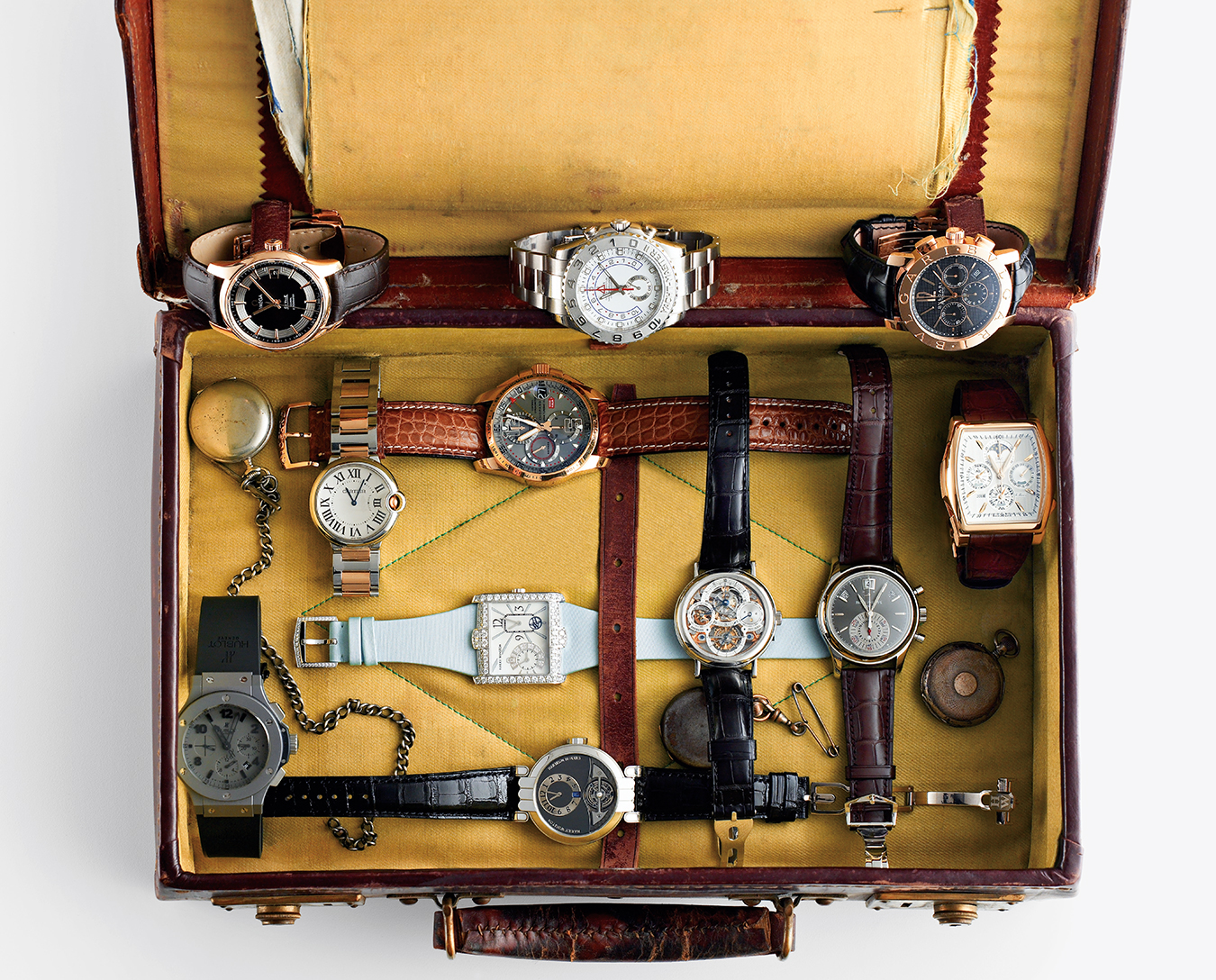Time Honoured
A brief history of the watch.

To a watch aficionado, there is no greater thrill than the annual watch fairs in Basel and Geneva. Every April in Basel alone, 100,000 buyers, sellers, collectors and journalists gather to be among the first in the world to discover the latest, greatest, fastest, thinnest, most complicated, most expensive and most outrageous watches during a week of presentations, parties and dinners.
So what’s all the fuss about? In a word, it’s about history. Far from being just another luxury product, watches were born out of two things: necessity and curiosity. Tracking time was—is—necessary for the organization of society. Even the ancients had meetings and lunch appointments to keep, not to mention crops to rotate. The notion of adornment, never mind brand status, didn’t factor into it until approximately 6,000 years after the invention of man’s first timekeeping device. Every timepiece made today has some counterpart from the past, and that is why the watch industry is obsessed with tradition. The more you know about the past, the more you can appreciate today’s innovations. So when someone puts a $1-million Patek Philippe Grand Complication in front of you and says, “See?” you will know just what it is you are meant to “see” (and why it costs what it does). It would take a book, or perhaps a series of books, to unspool every detail about the world of watchmaking, and that’s the beauty of horology. Here, then, is a brief look at the history of the watch.
It begins as early as 4,000 BC with the sundial. The Babylonians used this simple version of shadow measurement to divide day and night into 12 equal parts, giving us the familiar 24-hour day, the 60-minute hour and the 60-second minute. And astronomers as early as 200 BC invented sophisticated astrolabes, which used a series of discs that plotted the movement of the planets and the moon relative to the stationary stars to calculate local time, moon phases, longitude and zodiac information.
Other advancements in marking time included the obelisk, the hourglass, the water clock and, in the ninth century, the candle clock, a system of using candles tapered to different lengths. Along with the Babylonians, in fact, we have God to thank for the habit of marking time on a regular basis: around AD 604, the Pope introduced “canonical hours”, the custom of ringing bells at specific times of the day that were designated for reading devotions. Thus, in addition to serving as the keeper of souls, the clergy eventually became the primary timekeepers of Western Europe, using the candle clock to great effect throughout the late Middle Ages, during which few advancements in timekeeping were made and some (such as the astrolabe) were even lost.
It wasn’t until the 13th century that the church finally gave up wax and wick with the invention of the mechanical clock. The result was the proliferation of elaborate clock towers throughout Western Europe, many of them still standing today, which served as the universal time gauge for townspeople. Most of these wood-and-iron structures were made by blacksmiths, and featured weight-driven turret mechanisms that marked the hours with loud bells. By the middle of the 15th century, miniaturized versions—domestic mechanical clocks—began to appear in homes.
A century later, a Dutch scientist named Christiaan Huygens changed timekeeping forever by inventing the balance spring (also called the hairspring), which replaced the pendulum in a clock. Like today’s mechanical watches, Huygens’s inventions were powered by a mainspring, which fed a gear train, which led to the balance spring, which regulated the entire mechanism, causing the hands to move when they were supposed to. Huygens’s clocks were accurate to within minutes per day, thus giving the minute hand a reason to exist. The second hand soon followed, as watches and clocks became accurate to within seconds per day.
Far from being just another luxury product, watches were born of two things: necessity and curiosity.
God intervened a second time in the development of watchmaking via John Calvin, who, in the mid-16th century, made Geneva the world headquarters of Reformation Protestantism. He promptly legislated a ban on elaborate clothing and jewellery, leaving the area’s jewellers suddenly unemployed—until they discovered a loophole. Watches were considered practical, even respectable, and were therefore not part of the ban. Before long, Protestant watchmakers from France, Italy and Flanders flocked to Geneva, settling there and in outlying towns such as Neuchâtel and Berne, and in the Jura mountain region, areas that today remain famous watchmaking districts.
These and a handful of other, smaller brands were responsible for virtually all of the major advances in watchmaking during that time, including inventions such as the perpetual calendar, the chronograph, the flyback hand, the minute repeater and the tourbillon. Among the great watchmakers, Abraham-Louis Breguet remains the most celebrated. In 1783, he invented the gong spring, the chiming mechanism for minute repeaters. Before the discovery of electricity, repeater watches allowed time to be determined at night via an audible chime that sounded the hours and minutes, like a church clock-tower bell. In 1795, Breguet introduced his most famous complication, the tourbillon, a device that compensates for positional errors in the escapement that are caused by gravity. It remains one of the most difficult mechanisms to manufacture today, and is widely prized by collectors. Breguet also invented the overcoil balance spring, which greatly improved accuracy and is still used in high-quality mechanical watches. It remains one of the elite brands, and is renowned for its high-end complicated mechanical watches, along with Patek Philippe, Rolex, Vacheron Constantin and Audemars Piguet.
Women were the first to consider the convenience and adornment value of the wristwatch. Queen Elizabeth I is said to have worn the first bracelet watch in 1580 during a visit from the Pope (whose views on adornment diverged from those of John Calvin). The Queen of Naples commissioned a Breguet wristwatch in 1810, and Countess Kocewicz, a Polish noblewoman, specifically requested a Patek Philippe some years later. Thus began an important tradition: the watch as a fashion statement.
Men were no less inclined to adorn themselves, but preferred the more modest pocket watch, at least until the early 1900s. It took Louis Cartier, the famous French jeweller, to change that. In 1904, Brazilian socialite and aviator Alberto Santos-Dumont asked Cartier, a friend of his, to create a hands-free, leather-band wristwatch to use while flying his aircraft. Soon afterward, Cartier marketed the watch to the public, and the “pilot watch” was born. Watchmakers had for years toyed with the notion of a wristwatch, but it was Cartier who first produced it for popular consumption. Although it is known primarily as a maker of ladies’ jewellery watches and men’s dress watches, the company has also emerged as one of the elite, serious watchmakers of this era. This year, Cartier unveiled its first watch to bear the Geneva Seal: the $96,500 (U.S.) Ballon Bleu de Cartier Flying Tourbillon. “We have long been known as a woman’s brand, so this year we decided to depart from that by introducing what we consider to be the embodiment of what Cartier can do for men’s watches,” says Frédéric de Narp, president of the brand in North America.
Not surprisingly, competition among the elite producers has always been fierce. The early 20th century marked the race to create the thinnest wristwatch, a race that proclaimed a winner in 1929, when Jaeger-LeCoultre blasted the record with its Caliber 101. It measured 14 millimetres by 4.8 millimetres by 3.4 millimetres and weighed one gram; it is still used by the company today, notably in its tiny Riviera jewellery watches for ladies. The top brands also competed on the level of accuracy. From 1945 to 1967, two Swiss astronomical observatories, one at Neuchâtel and the other in Geneva, held annual precision-timekeeping competitions for wristwatch movements. During that pre-quartz era, mechanical wristwatches enjoyed something of a heyday, and competition to create the most accurate among them was fierce. Only movements—not cased wristwatches—were submitted, and the winners, including the names of the master watchmakers who regulated them, were published in the newspapers. The top players in this competition were Patek Philippe, Vacheron Constantin, Zenith, Girard-Perregaux, Longines and Rolex, whose chronometers were tested by the Kew Observatory in England, where marine chronometers were tested and certified prior to issue to the Royal Navy.
A number of factors elevated observatory chronometers to the rank of über-watch. Most had free-sprung balances, many of them Guillaume balances—made of brass and Invar steel, which produces incredible stability in a wide range of temperatures—often combined with a steel hairspring, which proved to be a winning combination. There were also Breguet overcoils and precisely engineered gears and pinions that minimized friction and optimized precise gear meshing. The surfaces of pinions and wheels were highly polished, with exceptionally even tolerances, and the dimensions of shafts and bearings were perfectly executed. But above all, these movements were built to be tweaked for peak performance, sometimes over a period of several weeks, and only the finest régleurs could really bring them to life. Like a finely tuned Formula One race car, they were built for competition. Few of the movements were cased, because they were never intended for serial production, so finding one is a rare pleasure for collectors.
As the observatory competitions progressed, so did technology. High-frequency, self-winding automatic movements, which would eventually become the standard in mechanical watchmaking, began to outnumber and occasionally outperform the rest. The competitions ended for two reasons: higher-frequency automatic movements, and quartz. In the late 1960s, the Japanese were allowed to enter the contests, and they were very good. Eventually, they perfected the quartz movement, which made the question of accuracy moot.
A quartz watch is run by a battery that activates a quartz crystal, which vibrates 33,000 times per second, driving the hands. It’s efficient because there are no gears or escapements to disturb the regular frequency. Although the Swiss are credited with inventing the quartz movement, they abandoned it for reasons that remain unclear, leaving the door open to the Japanese—specifically Seiko and Citizen—who mass-produced their own versions of quartz in the 1970s. The success of quartz dealt a serious blow to the Swiss, forcing the grand old watch houses to either join the quartz revolution or die a slow death. Many of the Swiss companies that still operate successfully today went through a period of stagnancy that lasted decades. Yet the vast majority of Swiss brands never stopped producing mechanical watches, even when few people were buying them.
Quartz ultimately helped the Swiss watch industry. It popularized the wristwatch and made it affordable for the masses. You didn’t have to be Queen Elizabeth to wear one, nor did you need a special occasion, such as an audience with the Pope. Affordability ushered in the concept of multiple ownership, and the notion of the watch wardrobe was born. As people clamoured for more elaborate styles and functions, something remarkable began to happen in the early 1990s: people took a renewed interest in mechanical movements, the more complicated the better. And the Swiss industry was reborn.
Every timepiece made today has some counterpart from the past, which is why the watch industry is obsessed with tradition.
Like the renaissance of the 1500s, which combined the advancements and aesthetics of 16th-century Europe with the tenets of classicism, the rebirth of mechanical watchmaking represents a perfect marriage of modern technology and the functions and traditions of the past. The same elite brands that invented mechanical watchmaking have in the past few years resurrected and revolutionized every horological function, from the minute repeater gong to the tourbillon escapement. Perhaps the greatest example of modern technology applied to ancient timekeeping principles is the reinvention of the astrolabe. In 2003, Patek Philippe created the Star Caliber, the world’s most complicated watch, with minute repeater and perpetual calendar indicating solar time, day, date, leap years, sunrise and sunset times, seasons, running equation of time (celestial time), 24-hour day and night indicators and the position of the sun, moon and stars. The same year, Ulysse Nardin presented the Trilogy of Time, a series of three watches that, combined, measure lunar and solar eclipses, sunrise and sunset, dawn and dusk, moon phases, moonrise, month and day of the week and zodiac information.
Breguet also recently resurrected something of its glorious watchmaking past. Last year, the brand reproduced Le Petit Trianon, also called the Marie Antoinette watch. The original watch, created in 1827 and valued at $11-million (U.S.), is a grande complication with perpetual calendar, minute repeater and equation of time with a power-reserve indicator.
In 1983, the original watch was stolen from the L.A. Mayer Museum of Islamic Art in Jerusalem, but recently turned up, 24 years later, at a Tel Aviv jeweller. It has been refurbished and is now back in the museum. When asked what might explain the hype and the recent surge of interest in mechanical watchmaking in general, Nicholas Hayek, chairman of the Swatch Group, which owns the Breguet brand (and many others), has a simple answer: “In today’s world of electronics and technology, where Internet, cell phones and search engines rule, a mechanical watch is a great alternative.” In a digital world, then, mechanical stands out as new and different. And thus, history repeats itself.
Yet the watch industry has improved on history a great deal. Even standard mechanical watches have been thoroughly overhauled in recent years. Movements work on the same principle, but component materials have improved significantly. In the past three years alone, watch geeks who roam the Basel and Geneva fairs have thrilled to the introduction of the silicium hairspring, the silicon pallet fork and escape wheel, the Glucydur (primarily beryllium) balance and the invention of the double, triple and even vertically inclined tourbillon escapements. Mechanical-watch producers are once again on top. Some have phased out quartz watches altogether. And once again, they are competing fiercely to create the latest, greatest, fastest, thinnest, most complicated and most expensive watches. And that is what all the fuss is about.




